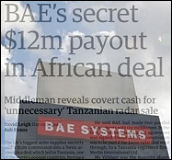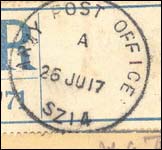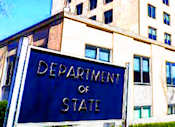 Almost one year ago, on March 4, 2010, this blog reported that the Directorate of Defense Trade Controls (“DDTC”) had posted a website notice that all BAE export licenses were on temporary hold. This came several days after BAE had pleaded guilty to charges that it had paid bribes in violation of the Foreign Corrupt Practices Act and failed to report them as commissions in violation of the Arms Export Control Act. DDTC said the hold was to allow the agency to consider the impact of BAE’s guilty plea. And then, almost as quickly as the notice appeared — poof! — it was gone.
Almost one year ago, on March 4, 2010, this blog reported that the Directorate of Defense Trade Controls (“DDTC”) had posted a website notice that all BAE export licenses were on temporary hold. This came several days after BAE had pleaded guilty to charges that it had paid bribes in violation of the Foreign Corrupt Practices Act and failed to report them as commissions in violation of the Arms Export Control Act. DDTC said the hold was to allow the agency to consider the impact of BAE’s guilty plea. And then, almost as quickly as the notice appeared — poof! — it was gone.
Well, the DDTC has apparently meditated on the fate of BAE long enough. An article in today’s Financial Times reported that BAE is bracing itself to have DDTC impose additional fines on the company and to suspend BAE’s privilege to export defense articles. Given BAE’s participation in such multilateral defense projects as the Joint Strike Fighter, it seems unlikely that the DDTC will impose a total export ban on BAE, but some version of an export ban is, apparently, both likely and imminent.
According to the Financial Times, the State Department was keeping mum on the matter but a BAE spokesperson had this to say: “Dialogue continues and is progressing with the Department of State in order to address its concerns regarding matters arising from the [Department of Justice] settlement.â€

 Posted by
Posted by  Category:
Category: 

 If there is anything that qualifies as a true urban legend in the export areas, it’s the surprisingly widespread belief that shipments to overseas APO and FPO addresses aren’t exports. Of course, that’s no more true than the belief that the fate of a rider on an equestrian statute can be determined by the position of the horse’s hooves. (
If there is anything that qualifies as a true urban legend in the export areas, it’s the surprisingly widespread belief that shipments to overseas APO and FPO addresses aren’t exports. Of course, that’s no more true than the belief that the fate of a rider on an equestrian statute can be determined by the position of the horse’s hooves. ( One of the jobs of this blog is to inform our faithful readers about changes that DDTC makes in its rules and guidelines but, for whatever reason, decides that it should keep secret. Currently Section 13.2(a)(3) of the Guidelines for Preparing Electronic Agreements (7 Oct 2009), requires applicants to attach to proviso reconsideration requests a separate scanned pdf copy of the DSP-5 Agreement approval. It also requires that the 9-digit DSP-5 number be referenced in blocks A and C of the continuation to Block 8.
One of the jobs of this blog is to inform our faithful readers about changes that DDTC makes in its rules and guidelines but, for whatever reason, decides that it should keep secret. Currently Section 13.2(a)(3) of the Guidelines for Preparing Electronic Agreements (7 Oct 2009), requires applicants to attach to proviso reconsideration requests a separate scanned pdf copy of the DSP-5 Agreement approval. It also requires that the 9-digit DSP-5 number be referenced in blocks A and C of the continuation to Block 8. This may look like U.S. Government blog week on ExportLawBlog, but it’s purely a coincidence. Yesterday we
This may look like U.S. Government blog week on ExportLawBlog, but it’s purely a coincidence. Yesterday we  WikiLeaks has gotten the State Department so flustered that it is leaking its own documents. Today DDTC posted a
WikiLeaks has gotten the State Department so flustered that it is leaking its own documents. Today DDTC posted a 

